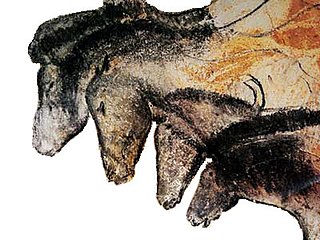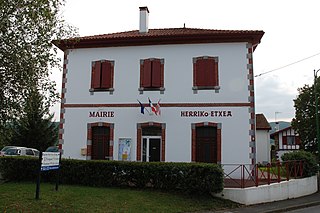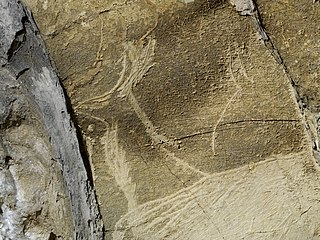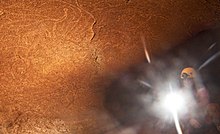
Cave paintings are a type of parietal art, found on the wall or ceilings of caves. The term usually implies prehistoric origin, and the oldest known are more than 40,000 years old, found in the caves in the district of Maros. The oldest are often constructed from hand stencils and simple geometric shapes. However, more recently, in 2021, cave art of a pig found in an Indonesian island, and dated to over 45,500 years ago, has been reported.

The Cave of Altamira is a cave complex, located near the historic town of Santillana del Mar in Cantabria, Spain. It is renowned for prehistoric parietal cave art featuring charcoal drawings and polychrome paintings of contemporary local fauna and human hands. The earliest paintings were applied during the Upper Paleolithic, around 36,000 years ago. The site was discovered in 1868 by Modesto Cubillas and subsequently studied by Marcelino Sanz de Sautuola.

The Chauvet-Pont-d'Arc Cave in the Ardèche department of southeastern France is a cave that contains some of the best-preserved figurative cave paintings in the world, as well as other evidence of Upper Paleolithic life. It is located near the commune of Vallon-Pont-d'Arc on a limestone cliff above the former bed of the river Ardèche, in the Gorges de l'Ardèche.

The Magdalenian cultures are later cultures of the Upper Paleolithic and Mesolithic in western Europe. They date from around 17,000 to 12,000 years ago. It is named after the type site of La Madeleine, a rock shelter located in the Vézère valley, commune of Tursac, in France's Dordogne department.

Lekeitio is a town and municipality located in the province of Biscay, in the Spanish Autonomous Community of Basque Country, 53 km (33 mi) northeast from Bilbao. The municipality has 7,307 inhabitants (2019) and is one of the most important fishing ports of the Basque coast. Tourism has an important role during the summer seasons, when the town is a resort with one beach called Isunza and the nearby Carraspio beach in the town of Mendexa.

Isturits is a commune in the Pyrénées-Atlantiques department in south-western France. It is located in the former province of Lower Navarre (Arberoa).

The prehistory of the Iberian Peninsula begins with the arrival of the first hominins 1.2 million years ago and ends with the Punic Wars, when the territory enters the domains of written history. In this long period, some of its most significant landmarks were to host the last stand of the Neanderthal people, to develop some of the most impressive Paleolithic art, alongside Southern France, to be the seat of the earliest civilizations of Western Europe and finally to become a most desired colonial objective due to its strategic position and its many mineral riches.

The Praileaitz Cave is located in the municipality of Deba.

The greater Basque Country comprises the Autonomous Communities of the Basque Country and Navarre in Spain and the Northern Basque Country in France. The Prehistory of the region begins with the arrival of the first hominin settlers during the Paleolithic and lasts until the conquest and colonisation of Hispania by the Romans after the Second Punic War, who introduced comprehensive administration, writing and regular recordings.

La Marche is a cave and archaeological site located in Lussac-les-Châteaux, a commune in the department of Vienne, western France. It is an archaeological site that has engendered much debate that has not been resolved to date. The carved etchings discovered there in 1937 show detailed depictions of humans and animals that may be 15,000 years old. The cave paintings at this site, however, are controversial and many doubt their authenticity.

The art of the Upper Paleolithic represents the oldest form of prehistoric art. Figurative art is present in Europe and Southeast Asia, beginning between about 40,000 to 35,000 years ago. Non-figurative cave paintings, consisting of hand stencils and simple geometric shapes, are somewhat older, at least 40,000 years old, and possibly as old as 64,000 years. This latter estimate is due to a controversial 2018 study based on uranium-thorium dating, which would imply Neanderthal authorship and qualify as art of the Middle Paleolithic.

Early European modern humans (EEMH), or Cro-Magnons, were the first early modern humans to settle in Europe, continuously occupying the continent possibly from as early as 56,800 years ago. They interacted and interbred with the indigenous Neanderthals, who went extinct 40,000 to 35,000 years ago; and from 37,000 years ago onwards all EEMH descended from a single founder population which contributes ancestry to present-day Europeans. Early European modern humans (EEMH) produced Upper Palaeolithic cultures, the first major one being the Aurignacian, which was succeeded by the Gravettian by 30,000 years ago. The Gravettian split into the Epi-Gravettian in the east and Solutrean in the west, due to major climate degradation during the Last Glacial Maximum (LGM), peaking 21,000 years ago. As Europe warmed, the Solutrean evolved into the Magdalenian by 20,000 years ago, and these peoples recolonised Europe. The Magdalenian and Epi-Gravettian gave way to Mesolithic cultures as big game animals were dying out and the Last Glacial Period drew to a close.

The Cantabrian caves' unique location make them an ideal place to observe the settlements of early humans thousands of years ago. The magnificent art in the caves includes figures of various animals of the time such as bison, horses, goats, deer, cattle, hands and other paintings. Archaeologists have found remains of animals such as bears, the remains of arrows and other material indicating a human presence; these artifacts are now found mostly in the Regional Museum of Prehistory and Archaeology of Cantabria.

The Cave of Altamira and Paleolithic Cave Art of Northern Spain is a grouping of 18 caves of northern Spain, which together represent the apogee of Upper Paleolithic cave art in Europe between 35,000 and 11,000 years ago. In 2008, they were collectively designated a World Heritage Site by UNESCO.

The Cave of Altxerri is located in the municipality of Aya (Gipuzkoa) in the Basque Country (Spain).

The Tito Bustillo Cave is a prehistoric rock shelter located in the small town of Ribadesella, in the autonomous community of Asturias, Spain. The cave was inhabited by humans (cro-magnon) before the year 10,000 BC. Due to the collapse of the rock, the original entrance to the cave was sealed thousands of years ago, which made it possible for preservation of objects, tools and wall paintings that were discovered in 1968. Based on those objects found in the cave, it is known that there was a significant human presence during the Magdalenian culture of the Upper Palaeolithic, but the cave was probably inhabited before that time.

The Vogelherd Cave is located in the eastern Swabian Jura, south-western Germany. This limestone karst cave came to scientific and public attention after the 1931 discovery of the Upper Palaeolithic Vogelherd figurines, attributed to paleo-humans of the Aurignacian culture. These miniature sculptures made of mammoth ivory rank among the oldest uncontested works of art of mankind. In 2017 the site became part of the UNESCO World Heritage Site "Caves and Ice Age Art in the Swabian Jura".

The La Garma cave complex is a parietal art-bearing paleoanthropological cave system in Cantabria, Spain. It is located just north of the village of Omoño, part of the municipality of Ribamontán al Monte. The cave complex is noted for one of the best preserved floors from the Paleolithic containing more than 4,000 fossils and more than 500 graphical units. It is part of the Cave of Altamira and Paleolithic Cave Art of Northern Spain World Heritage Site.

Vasco-Cantabria, in archaeology and the environmental sciences, is an area on the northern coast of Spain. It covers similar areas to the northern parts of the adjacent modern regions of the Basque country and Cantabria. In geology the "Vasco-Cantabrian Basin" or "Basque-Cantabrian Basin" covers the area and the seas off the coast, in the Bay of Biscay, an area between the Iberian and European tectonic plates.





















